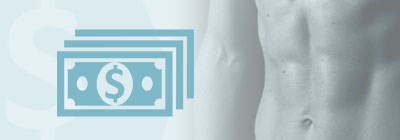The overall quality of the elasticity of your skin might be the single most important factor linked to your final result. Most of us tend to lose a bit of the “snap-back” and tone of the skin with time. Add in a baby or two, significant weight loss, and some stretch marks – these all increase your risk for limited elasticity. Yet, it is this all important degree of elastic tone that plastic surgeons count on for getting you the best results from liposuction. Think of your skin as a stretchable envelope for your fat. Once the fat has been removed, the skin must shrink back and re-conform to the body’s smaller, new shapes and contours for everything to look right. If the skin envelope is like “spandex”, then there’s no problem. If the skin is more like a loose sweater – we may have a problem. If the skin has limited ability to recoil, then wrinkles, irregularities, “jiggly” or even hanging skin could result after liposuction! You might have very nice skin tone in one area (e.g. your arms) making you a great candidate for liposuction but at the very same time you might also have limited tone in another area (e.g. inner thighs) making you a very poor candidate for liposuction! What many patients think of as simply excess fat is often actually a fairly modest amount of fat and more of a loose skin issue! How do you know if your skin tone is good and that you are truly a good candidate for liposuction? This is best determined by an in-office consultation with your expert – a board certified plastic surgeon. There are some special forms of liposuction, such as laser liposuction (i.e. Smartlipo) which may be good to consider when the skin tone is marginal or borderline. But even laser liposuction can’t make skin which is prohibitively loose magically tight…and no technology we have available today really can. There are alternatives to liposuction when loose skin must be addressed – most of these are various types of “lifts”.
Having your procedure performed in a “real” operating room is often safer, quicker, and more likely to give you the kind of result you are looking for. Office liposuction sounds great doesn’t it? No anesthesia, walk in/walk out, less expensive, easier to schedule, etc. But it is not for everyone and many times is a poor individual option. Think about what this choice really involves before assuming it will be the ideal way for you to have your liposuction procedure. Those with significant anxiety are not going to appreciate the various “sights and sounds” that are associated with their procedure that they will be witness to, whether they want to or not. All of these procedures involve local anesthetic – sometimes called the “tumescent solution” – which must be injected thoroughly into each area before any type of liposuction begins. These areas have to be rendered numb but they are not instantly and completely numb – you will feel this process. And the best working local anesthetic does not guarantee that you will feel absolutely nothing in the way of discomfort from the beginning of the procedure until the end. In fact, it is fairly likely that at one point or another, even after the local has “kicked in”, you will experience some discomfort. If you will be receiving I.V. sedation, you will need an I.V. Are you OK with that? Who will be monitoring your breathing and other vital signs while you slip in and out of a twilight state? Who will be in charge of making sure that you get enough of the sedation drugs but not too much? If it is not an anesthesiologist, you won’t have the expert you should have to make sure nothing goes wrong or to act immediately if something unexpected happens. How long will the procedure take? In the operating room, with you safely asleep, aware of nothing, feeling nothing, liposuction of large or multiple areas can proceed efficiently, safely and in a timely fashion. When you awaken, your procedure is completely done, even though it might feel like only moments have passed since you closed your eyes. Not so with an office procedure, which by its very nature must be done slower and takes longer. Sometimes it takes a lot longer, in the same room, as time passes in a way that is the exact opposite of that “blink” of the O.R. experience. How aggressive and definitive a fat removal and reshaping do you envision? Given the issues above, under which set of circumstances do you see your surgeon being able to do his thorough best, all the while concentrating exclusively on the sculpting and the shaping of your body?
Post-operative discomfort after liposuction is generally minimal and of short duration. Most patients will say they feel a little sore here and there, reminding them of that achy kind of feeling when they have had the flu or overdid it at the gym. It is rare for someone to have significant pain following liposuction, and within a day or two (e.g. a weekend), most patients will be essentially off their pain pills. Of course, more areas done at one time will mean more areas that are sore and a few “ouchy”s” with certain movements or positions for a few days, but it is all very tolerable. This cannot be said of something like a tummy tuck, which can be associated with some significant discomfort for at least a week plus.
You’re likely to see at least some improvements right away, but the final results won’t arrive for weeks and sometimes even months. Even with the swelling and bruising that will accompany and somewhat obscure your results within the first few days after your liposuction, you should still be able to see that something good really did happen. As the days pass, the swelling and bruising will slowly disappear, and the skin and the underlying tissues will be better able to shrink and smooth down. As the weeks pass, this process will continue more and more and your results will gradually look and feel better and better. The apparent results after one month will be noticeably better than they were by the end of that first week, but not nearly as good as they will be by month 2 or 3. In fact, the final results, including more normal sensation, texture, and suppleness will be a process not likely to be complete for some 9 – 12 months!
What might appear to be hard, lumpy or uneven areas in the early phases of healing are almost always temporary and very common. These sorts of issues happen in almost every liposuction case because they represent the normal way the body often responds to the “trauma” of the procedure itself. They are temporary side effects of the procedure, artifacts of the process, which are usually more feel-able than they are visible. One day there is a “lumpy” spot, and then the next day, it’s gone but wait…now it’s over here! The body is gradually recovering and healing underneath the skin – lots of changes like this will take place. Did you ever notice all the changes that a wound or scar you had once went through on the outside? Thick or red or lumpy in the early phases of healing followed by a maturing and settling in that was clearly an improvement over what you saw at first. Imagine this same process playing out underneath the skin. That is where all the real healing will be taking place – not in the little nick you will see on the outside that was merely the “access” point for your liposuction. Hey – there’s a persistently thick, hard and tender spot over here (where some “extra” work might have been needed?) but right next to it the sculpted area is already flat and smooth? Different areas recover at different rates, especially if they were also intentionally addressed differently from a surgical perspective. If your doctor’s proper recommendations for a good recovery are followed, most of these issues will sort themselves out nicely within the first few weeks. After that, massage, stretch and activities (gym, exercise, sports) will further improve and enhance the results along the way.
Dr. Lyle Back is originally from New York City, receiving his medical and surgical training at Rutgers Medical School, Cooper Hospital – University Medical Center, and Ohio State. He is Board Certified in General Surgery (ABS) and Plastic Surgery (ABPS). He is a Fellow of the American College of Surgeons (ACS), the American Academy of Cosmetic Surgery (AACS), and a longstanding member of the premier American Society of Plastic Surgeons (ASPS). He served as a Professor of Plastic Surgery at Temple University and St. Christopher’s Hospital for Children and performed reconstructive surgery with “Operation Smile” in Vietnam. He specializes in the full range of the most modern and state of the art cosmetic surgery procedures for the body and non-surgical cosmetic enhancement techniques available today.


